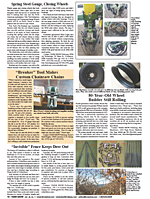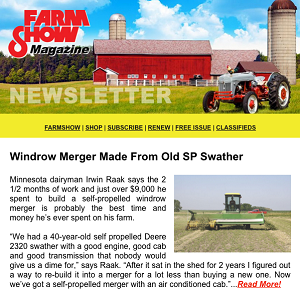"Hoop House" Glides Open And Closed
Vern Harris likes setting up hoop houses over his vegetable beds, but he doesn’t like the hassle of working under them. Most designs require lifting the plastic sides to get at the produce. So, Harris came up with hoops that glide on rails, making access as easy as pulling on two ropes.
“Anybody who is even slightly mechanical can build one,” says Harris. “If they run into trouble, I’d be glad to help. My hoop houses have let me grow greens even in the snow.”
Harris lives in Northwestern Washington State where winter temperatures are commonly in the 30’s and 40’s so hoop houses make year-round gardening possible.
Harris builds his garden beds from 8-ft. long, 2 by 6-in. untreated fir. The main component of the hoop house is schedule 40 pvc pipe. The rails the house slides on are 3/4-in. diameter pipe. The hoops are 1/2 in. diameter. They fit into 1-in. diameter tees that glide over the rails.
“I needed to raise the rails slightly above the bed sides so the tees can glide down the rail,” says Harris. “To get the height, I predrilled holes through the pipes and set 1/2-in. long pieces of 1/2-in. aluminum tubing under the holes. Screws driven through the holes and through the tubing secure the rails in place.”
Harris then sliced away the bottoms of each hoop tee. This allows them to slide down the rail and past the aluminum supports. He also extended the rails about 18 in. past one end of the bed so all the hoops could be pulled to that end, exposing the entire bed to the sunlight. A piece of 3/4-in. pipe was attached to the rails at the overlapping end with 90° angle connectors.
After placing 5 tees in place on each rail, Harris inserted a 9-ft., 1/2-in. pvc pipe in a tee on one side and then bent it to fit the other end into the opposing tee. He predrilled holes for attaching the plastic. Harris advises using Dura-Film Thermax or another high quality film recommended for hoop houses.
"I cut a plastic sheet to 9 by 10 ft. and attached it to the hoops with the 9-ft. side running the length of the 8-ft. bed and hanging over each end by 6 in.," says Harris. "The 10-ft. dimension was fastened so edges overlapped hoop ends by 6 in. I used 1/2-in. lathe screws with washer heads to help prevent tears and leaks."
To enclose the ends, Harris cut two 4 by 5-ft. pieces of plastic. He attached one to the hoop at the extended end of the bed using fasteners. The other is temporarily clamped to the end hoop when the hoop house is closed.
"You could even use clothes pins, but I go to a dollar store and find inexpensive clamps for the hoops," says Harris. "I fasten the bottom permanently to the bed frame."
To make opening easy, he installed 3/16-in. eye screws at the bottoms of each side of the front rail. To these he attached lengths of 3/16-in. clothesline cord. To open or close the hoops, he simply pulls on the cords.
"In my climate a single layer of plastic is enough to keep my hoop houses from freezing on our coldest days," says Harris. "In a colder climate, you could attach a second layer of plastic to the inside or outside of the hoops. It's well worth it either way. Those fresh garden greens taste great in January and February."
Harris is willing to help with information, a complete parts list or even parts ordering. If desired, he will even prepare a hoop house kit to order.
Contact: FARM SHOW Followup, Vern Harris (gardenhoop@gmail.com).

Click here to download page story appeared in.
Click here to read entire issue
Hoop House Glides Open And Closed BUILDINGS New Techniques Vern Harris likes setting up hoop houses over his vegetable beds but he doesn’t like the hassle of working under them Most designs require lifting the plastic sides to get at the produce So Harris came up with hoops that glide on rails making access as easy as pulling on two ropes
“Anybody who is even slightly mechanical can build one ” says Harris “If they run into trouble I’d be glad to help My hoop houses have let me grow greens even in the snow ”
Harris lives in Northwestern Washington State where winter temperatures are commonly in the 30’s and 40’s so hoop houses make year-round gardening possible
Harris builds his garden beds from 8-ft long 2 by 6-in untreated fir The main component of the hoop house is schedule 40 pvc pipe The rails the house slides on are 3/4-in diameter pipe The hoops are 1/2 in diameter They fit into 1-in diameter tees that glide over the rails
“I needed to raise the rails slightly above the bed sides so the tees can glide down the rail ” says Harris “To get the height I predrilled holes through the pipes and set 1/2-in long pieces of 1/2-in aluminum tubing under the holes Screws driven through the holes and through the tubing secure the rails in place ”
Harris then sliced away the bottoms of each hoop tee This allows them to slide down the rail and past the aluminum supports He also extended the rails about 18 in past one end of the bed so all the hoops could be pulled to that end exposing the entire bed to the sunlight A piece of 3/4-in pipe was attached to the rails at the overlapping end with 90° angle connectors
After placing 5 tees in place on each rail Harris inserted a 9-ft 1/2-in pvc pipe in a tee on one side and then bent it to fit the other end into the opposing tee He predrilled holes for attaching the plastic Harris advises using Dura-Film Thermax or another high quality film recommended for hoop houses
I cut a plastic sheet to 9 by 10 ft and attached it to the hoops with the 9-ft side running the length of the 8-ft bed and hanging over each end by 6 in says Harris The 10-ft dimension was fastened so edges overlapped hoop ends by 6 in I used 1/2-in lathe screws with washer heads to help prevent tears and leaks
To enclose the ends Harris cut two 4 by 5-ft pieces of plastic He attached one to the hoop at the extended end of the bed using fasteners The other is temporarily clamped to the end hoop when the hoop house is closed
You could even use clothes pins but I go to a dollar store and find inexpensive clamps for the hoops says Harris I fasten the bottom permanently to the bed frame
To make opening easy he installed 3/16-in eye screws at the bottoms of each side of the front rail To these he attached lengths of 3/16-in clothesline cord To open or close the hoops he simply pulls on the cords
In my climate a single layer of plastic is enough to keep my hoop houses from freezing on our coldest days says Harris In a colder climate you could attach a second layer of plastic to the inside or outside of the hoops It s well worth it either way Those fresh garden greens taste great in January and February
Harris is willing to help with information a complete parts list or even parts ordering If desired he will even prepare a hoop house kit to order
Contact: FARM SHOW Followup Vern Harris gardenhoop@gmail com
To read the rest of this story, download this issue below or click
here to register with your account number.








